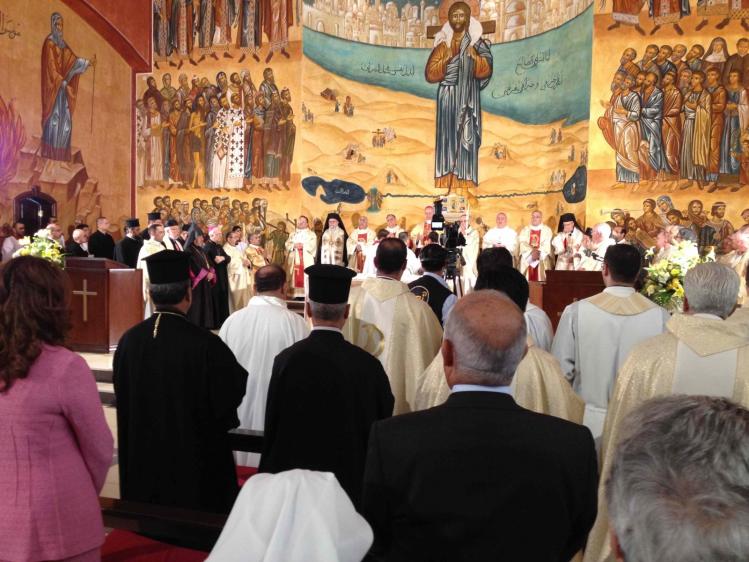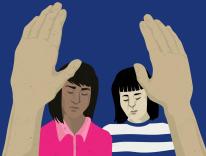
Last week, here in Amman, we celebrated the feast of St. Francis of Assisi and the pope who bears his name. Parishes held large Masses, and the Franciscans friars at the well-known Catholic school Terra Sancta College performed their annual ritual commemorating the life and work of their patron. The Jordanian Catholic television channel Noursat/Telelumiere (Light TV) live-streamed Francis’s visit to Assisi and provided immediate Arabic translation of his remarks.
The most important event was a Mass in honor of the pope hosted by Apostalic Nuncio Giorgio Lingua, the Vatican’s ambassador to Jordan. Though the Mass was an elaborate affair with many non-Catholic guests, a large youth choir, posters of the pope, and a post-Mass reception, it has not yet been covered in English-language news outlets.
This post isn’t an attempt to cover the event from a journalist’s perspective. Instead, because I was in attendance as a worshipper, I hope to share some of my own reflections on the significance of the service. The Mass reflected ways in which the spirit of the two Francises is alive and well the Catholic Church in Jordan, and it illustrates what the global church can learn from the church in the Holy Land.
Nuns on a bus
Many of those in attendance at the Mass, which was held outside Amman at Our Lady of Peace Center, a Catholic-run complex that serves individuals with special needs, were nuns. Nuns from numerous orders and nationalities live in Jordan, including the Comboni Sisters who work in Amman’s Italian hospital. I met these sisters, who hail from Italy, Egypt, Syria, Poland, and Singapore, on the bus ride to the service, and I continue to see them at morning Masses at Amman’s Jesuit Center. Their humble ministry reflects two of the values promoted by Pope Francis and his namesake: simplicity and accompaniment. These sisters left their home countries to live and work among the sick of Jordan. These nuns are a reminder that the church is not just one in service of the poor, but of the poor.
What Christian unity looks like
The Mass was not just a celebration by Catholics, but by leaders of other faiths in this religiously diverse area. Representatives from Orthodox and Coptic Churches were easily noticeable from their distinctive garb. Other Eastern leaders entered alongside dozens of Roman Catholic priests as the Mass began, including Ecumenical Patriarch Bartholomew, who sat beside the Catholic leaders on the altar, beneath a large icon of Jesus the Good Shepherd.
In his homily, Archbishop Fouad Twal, head of the Archdiocese of Jerusalem, which includes Jordan, Israel and the Palestinian territories, and Cyprus, spoke about the unifying nature of Pope Francis’s papacy: “His Holiness is a source of pride for us, because during the short time of his papacy, not more than seven months, the pope has been able to seize the hearts of many people, enthrall them with his goodness and simplicity and angelic smile, whether they be Christians or non-Christians.”
Ecumenism has become the name of the game among the Holy Land’s Christians. The Christian community here is dwindling; many Christians have emigrated to the West because of civil wars, violence, and religious persecution (reasons that are the subject of another post.)
The Holy Land Christian Ecumenical Foundation (HCEF) is one example of on-the-ground ecumenical work. HCEF provides spiritual and material support for Palestinians from their offices in Bethlehem (and Washington, D.C.) in addition to spreading awareness about the plight of Palestinian Christians.
Over the past fifteen years, the Catholic Church here has observed Lent and Easter according the Orthodox calendar. Adopting the Orthodox date for Easter is an example of a concession that Catholics have made to further Christian unity in the region. The Easter celebration example illustrates that Catholics, if they truly want the Christian unity that Pope Francis and so many talk about, must be ready to make compromises. And they must understand that a more unified church does not necessarily mean a more uniform one. A realistic Christian unity will be characterized by diversity in worship and practice.
The Amman message
In his homily, Archbishop Twal also discussed the pope’s recent meeting with the Muslim king of Jordan, Abdullah II, and the pontiff’s letter to the Muslim world on the occasion of Ramadan. Francis’s outreach to Muslims has indicated a desire to strengthen Muslim-Christian relations. Though relations between the world’s two largest faith groups seem perilous in the Middle East today, in Jordan they have been historically quite good.
Christians and Muslims have lived side-by-side in the land that is now Jordan for over a thousand years. The two religions are both fixtures in Jordanian society, and even though the Christian population is a small one, its presence can be felt, thanks to the many Christian churches and holy sites around the country. However, owing to more recent world events—from the creation to the state of Israel and the September 11 attacks to Western imperialism and missionary activity in the Middle East (and a host of other factors)—tensions have risen between Christians and Muslims here.
Consequently, Jordan’s monarchy has made interreligious dialogue between Christians and Muslims a high priority. Earlier this fall, King Abdullah, who founded UN’s World Interfaith Harmony Week, hosted a conference called “Challenges Facing Arab Christians.” The Royal Aal al-Bayt Institute for Islamic Thought, an organization affiliated with the monarchy, has put forward a number of initiatives (like the Amman Message) to inform the West about Islam.
Leaders who advocate for Muslim-Christian dialogue in Jordan were present at the Mass for Francis. Dr. Kamel Abu Jaber is a Christian who directs the Royal Institute for Interfaith Studies, and Fr. Nabil Haddad is an Orthodox priest who heads the Jordanian Interfaith Coexistence Research Center. Jesuits who are spearheading dialogue initiatives were also present. The Jesuit Center is currently putting on its first “Culture Experiment,” which brings together groups of young people from different backgrounds (Jordanian, Syrian, Iraq, Filipino, Sudanese, and Somali) to collaborate on a dance performance, and, in the process, bridge their own cultural and religious divides.
Interreligious dialogue and engagement—both important to Pope Francis—are already at work here in the Holy Land.
A papal visit?
Rumors have been circulating that Pope Francis may visit Jordan when he makes his trip to Jerusalem next year. Though formal plans have not been made, the Bishop of Jordan, Maroun Lahham, has indicated that Pope Francis may want to visit the Zaatari refugee camp in the north of Jordan, since the pope has been vocal about the plight of refugees. If he does visit, he will be pleased to see that many of his priorities and goals are being met here: simplicity, accompaniment, ecumenism and dialogue. True, the church here isn’t perfect, and it doesn’t always live up to its ideals. But it is not hard to find examples of the poor and open church that the Francises envision.
Click here to see a photo gallery from the Mass.
Note: An earlier version of this article mistakenly said that Dr. Kamel Abu Jaber is a Muslim. The article has been corrected to state that he is Christian.
Please email comments to [email protected] and join the conversation on our Facebook page.
Share
Previous Story
Francis the Street Pope
Next Story
Self-gerrymandering
